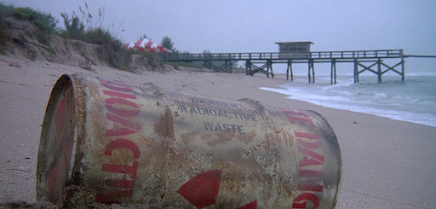There are cinematic misfires, and then there is The Beatniks, a film so wildly off-target it could only have been named during a caffeine crash in a marketing meeting. As a teensploitation crime flick marketed to the tambourine-beating, beret-wearing pseudo-intellectuals of Eisenhower-era America, it has precisely nothing to do with beatniks. No jazz poetry. No, Ginsberg. Not even a bongos-on-the-beach scene. What it does feature is a gang of vaguely surly young men, a meteoric music career achieved in 24 hours, and a plot twist that plays like it was written on a bar napkin after two Schlitz and a hit of cough syrup.
🎞️ A Sideburn by Any Other Name
Originally titled Sideburns and Sympathy, which sounds less like a movie and more like an Elvis-themed therapy retreat, the film was born in 1958 and released a year later, only to stumble into obscurity like a greaser at a beat poetry reading. Directed by Paul Frees, yes, that Paul Frees, the ubiquitous voice behind everything from Disneyland’s Haunted Mansion to Pillsbury Doughboy commercials, this was his one and only venture behind the camera. And after 72 minutes of existential confusion masquerading as plot, one sees why.
To its credit, The Beatniks does reflect a larger trend of late-1950s youth exploitation cinema, where “cool” titles were stapled to scripts in the hopes of attracting drive-in teens with pocket money and questionable taste. Producer Elmer Carl Rhodan Jr., a figure in the Midwestern theater chain world and a purveyor of similar cinematic curios (Daddy-O, The Delinquents), tragically passed away in 1959. One can only hope his final moments did not involve a screening of this film.
🎭 The Grease Paint Never Dries
Front and center is Tony Travis as Eddy Crane, a petty criminal with an uncanny ability to croon his way out of armed robbery. After accosting a record executive with the gang (as one does), Eddy belts out a song in a diner and is instantly deemed an “overnight sensation.” Within five minutes of screen time, he’s got a recording contract, a TV special, and a wandering eye for the producer’s secretary, played by Joyce Terry in the most wooden performance this side of a Sears mannequins’ union.
Karen Kadler’s Iris, the jilted girlfriend, pines away while the gang disintegrates into melodramatic angst. Peter Breck as “Moon” provides the film’s clumsy stab at tragedy when he kills a bartender for no real reason other than, presumably, needing to give Eddy a moral dilemma. This is resolved when Eddy turns Moon in—a move that is apparently both noble and criminal, depending on which scene you’re watching. It’s as if someone rewrote Rebel Without a Cause while suffering a head injury.
📉 Reception, Repercussions, and Retroactive Ridicule
The film, predictably, vanished into the mist of second-run theaters and VHS obscurity—until it was resurrected (or rather, exhumed) by Mystery Science Theater 3000 in Season 5, Episode 15. Joel and the Bots had a field day with it, and rightly so. Rarely does a film hand its satirists such low-hanging fruit: a misleading title, a paper-thin plot, and acting choices so baffling they feel like performance art.
Film historians, in their more charitable moods, occasionally cite The Beatniks as an interesting artifact of postwar American youth culture. But let’s be honest, interesting in the way your neighbor’s backyard taxidermy collection is interesting. The only real legacy here is the ironic kind: a cautionary tale in film schools and late-night cult circles of how not to title, direct, or cast a movie.
🎤 A Film Best Left in the Jukebox
In sum, The Beatniks is a cinematic bait-and-switch so audacious it almost deserves respect. Almost. Paul Frees may have been a voiceover legend, but his sole outing as a director lands with all the subtlety of a cymbal crash in a monastery. If you’re a fan of misplaced ambition, tonal whiplash, and noir-lite nonsense with a dash of jukebox cheese, this may be your holy grail. For the rest of us, it’s a one-star relic best left to the MST3K vault and the annals of drive-in misfires.
#NotAMovieAboutBeatniks #MST3KSalvation #SideburnsAndSorrow #TeensploitationTragedy #PaulFreesPleaseNo #FinalFilmFollies #CrooningCriminals #MidcenturyMisfires











